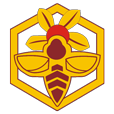Honey-Based Recipes
Pancakes with cheese and honey
Ingredients:
• 2-3 eggs
• 2 1/2 glass of water
• 1/2 kg flour
• 1/2 kg feta cheese
• honey
• salt (if feta cheese is not salty)
• olive oil
Preparation:
Mix all the ingredients (except for the honey), adding the four little by little.
Blend everything and until the mixture becomes viscid.
You pan in boiling olive oil.
Add honey and serve it hot.
Chicken with strawberries and honey
Ingredients:
- 500 gr chicken breasts
- 5 strawberries
- 2 carrots
- 1 onion
- 4 colourful peppers
- 100 gr mushrooms
- 1/2 teacup soya
- 1 teacup tomato ketchup
- 1/2 teacup water
- 5 tablespoons balsamic vinegar
- 2 tablespoons honey
Preparation:
- Chop the carrots, the onion, the peppers and the mushrooms
- Fry the chicken for a while and add the vegetables
- Put away the pan from the heat and add the soya sauce
- Put the pan to heat again
- In a bowl mix the water well, the tomato ketchup and add it to the chicken
- Let it fry for 5 more mins
- Add the honey and the vinegar and fry for a few mins
- Serve with the chopped strawberries
Salad dressing
Ingredients:
- 1 teacup olive oil
- 1/2 teacup vinegar (from white wine)
- 1/2 teacup honey (about 3 spoons)
- 1 tablespoon lemon juice
- 2 tablespoons mustard
Chocolate cake with honey and almonds
Ingredients:
- 230 gr bitter chocolate
- 5 tablespoons honey
- 175 gr butter
- 30 gr finely chopped almonds
- 100 gr semi-mashed almonds
- 3 spoon flour
- 5 eggs
- 1/2 cups water
- 2 tablespoons almond liqueur or 3-2 drops of bitter almond essense
- powdered sugar for dusting
Preparation:
- Put the chocolate in a saucepan, add 3 tablespoons of water over low heat to melt, stirring constantly. Then add the honey and when mixed download the mixture from heat
- Preheat the oven to 180 degrees
- Add the butter cut into pieces into the chocolate mixture and stir until melted
- Add the mashed almonds, the flour and the baking powder
- Separate egg whites and yolks. Mix the egg yolks to the chocolate mixture and beat the egg whites into meringue
- Mix the meringue smoothly into the mixture, add the chopped almonds and finally flavour the mixture with the liqueur
- Use round cake pan and bake for approximately 1 hour
- Take the cake of the pan and let it cold
- Top with powdered sugar
- Serve it with fresh fruits and whipped cream

What is Apiculture?
Apiculture is the management and study of honeybees.
Apiculture is the management and study of honeybees.
Apiculture is derived from the honeybee's Latin name Apis mellifera, meaning ‘honey gatherer’. Since bees do not collect honey but nectar from which honey is made, the scientific name should actually be Apis mellifica meaning ‘honey maker’.
Although apiculture refers to the honeybee, the vital role all bees play in the pollination of crops and flowering plants has caused apiculture to also include the management and study of non-Apis bees such as bumblebees and leafcutter bees.
Some 90 million years ago, flowering plants first appeared on earth. The wasp-like ancestors of bees took advantage of the food made available by flowers and began to modify their diet and physical characteristics.
Since then, flowering plants and bees co-evolved. This eventually led to a complete interdependence, meaning that flowering plants and bees cannot live and reproduce without each other.
Since then, flowering plants and bees co-evolved. This eventually led to a complete interdependence, meaning that flowering plants and bees cannot live and reproduce without each other.
The genus Apis is comprised of a comparatively small number of species including the western honeybee Apis mellifera, the eastern honeybee Apis cerana, the giant bee Apis dorsata, and the small honeybee Apis florea.
Honeybees are indigenous to the Eurasian and African continents and were introduced to the Americas and Australia by European settlers.
The western honeybee is comprised of some 24 races or sub-species. The African honeybee, sometimes referred to as ‘Killer bee’, is a race of the western honeybee and can therefore cross-breed.
Bees collect pollen and nectar. Pollen is the protein source needed for bee brood development while nectar is the carbohydrate source providing energy.
Nectar is a sugar solution produced by flowers containing about 80% water and 20% sugars. Foraging bees store the nectar in the ‘honey sac’ where the enzyme invertase will change complex sugars into simple sugars called mono-saccharides. Upon return to the hive, the foraging bee will disgorge the partially converted nectar solution and offer it to other bees. Housekeeping bees will complete the enzymatic conversion, further removing water until the honey solution contains between 14 – 20% water.
Honey is too dry for any microbes to live in. Honey is non-perishable and can be kept indefinitely in a cool, dry place.
The flavor, aroma and color of honey is determined by the floral source. For example, buckwheat honey is almost black while fireweed honey is almost colorless.
Unlike other bees, honeybees can communicate details about the location, quality and quantity of food sources. This allows honeybees to access and utilize food sources efficiently at great distances.
Honeybees maintain temperatures in the brood nest of between 30º C and 34º C, even in the middle of winter.
The honeybee colony is comprised of one queen, thousands of worker bees and a few hundred male bees called drones. Colony size varies according to season and condition of the colony.
Several diseases including viruses, various microbes and mites can affect the honeybee.
Honeybees are used in pollination and play a critical role in the production of many crops, representing a value of over $14 billion per year in North America.










